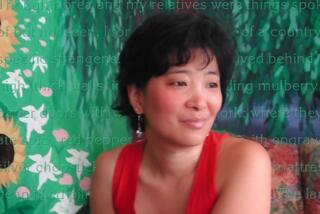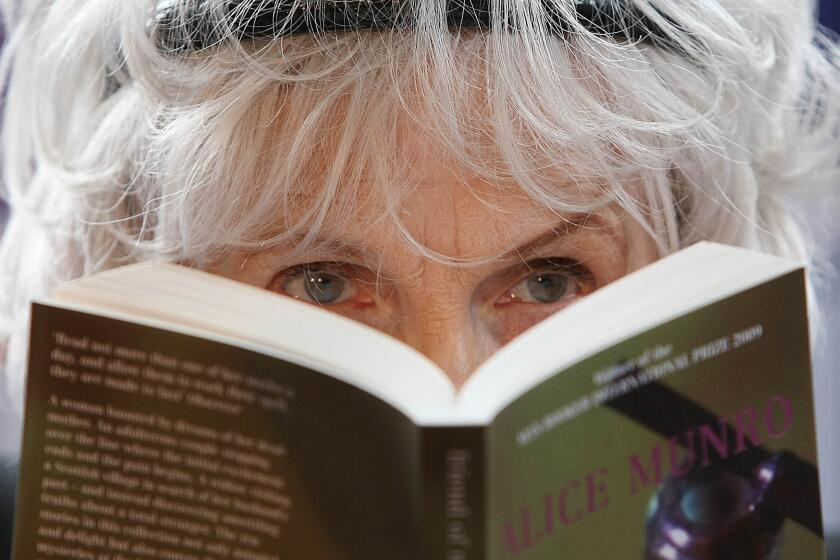BOOK REVIEW : Lyrical Lines for the Rimbaud of Rock : BOB DYLAN Behind the Shades; <i> Clinton Heylin</i> , Summit $22.95, 478 pages
“I’m only Bob Dylan,” announced Robert Allen Zimmerman in a 1986 press conference, “when I have to be.”
The remark is quoted early in “Bob Dylan” by Clinton Heylin, an unauthorized (but mostly reverential) biography, and it nicely sums up what the book is really all about. “Bob Dylan” is a catalogue of the many faces and phases of Bob Dylan: first a Woody Guthrie wanna-be, then the Rimbaud of rock ‘n’ roll, a “born-again” Christian troubadour, an ecstatic Hasid, a Travelin’ Wilbury.
One begins to imagine, at last, that Madonna learned a lesson or two from Mr. Zimmerman.
“The ability to constantly reinvent who Bob Dylan was, and is, remains the primary characteristic of his art,” Heylin writes. “The triumph of his career has been the way he has constantly inverted, desecrated or just downright stomped upon audience expectations, and yet his artistry has survived each chameleon twist.”
Heylin is a dedicated and accomplished Dylanologist with the credentials to prove it. He’s one of the founders of something called Wanted Man, “the Bob Dylan Information Office,” and its journal, the Telegraph. He announces without apology that he regards Dylan as one of only four “artistic geniuses” to emerge from the popular culture. (The other three? Fred Astaire, Orson Welles and Jimi Hendrix!)
Heylin cheerfully admits that he did not interview Bob Dylan, but he argues persuasively that it’s not really necessary. Instead, he has culled quotations from Dylan (and men and women who have known him well) from more than 30 years of clips, including a decade’s worth of interviews conducted for the Telegraph, and he artfully arranges and expertly annotates these nuggets of commentary and reminiscence and revelation to create a composite portrait of the Artist as Changeling.
Heylin faults the earlier (and authorized) biographies of Dylan for failing to discern between myth and reality and for stopping short of Dylan’s latest transfigurations, and so his book starts with Dylan’s birth in Duluth, Iowa, and rolls all the way up to Dylan’s 1990 performances (which suggest to Heylin that “his drinking habits are not always under tight rein”).
Along the way, Heylin leaves no rolling stone unturned in his search for the real Bob Dylan. As a result, much of his book is devoted to the detail only a fan can love. Which of Dylan’s high-school girlfriends was “the ‘real’ Girl from the North Country”? Exactly how serious were his injuries in the near-mythic motorcycle accident of 1966--or was it just a way to weasel out of his recording contract?
Still, you don’t have to be a Dylan fan to have fun with Heylin’s book, which is funny, discerning and occasionally even irreverent. Indeed, Dylan comes across as cranky, arrogant and downright boorish, as when he heckled another performer at a nightclub: “I don’t (expletive) have to keep quiet,” he protested when asked to stop. “I’m Bob Dylan.”
The moments of greatest boorishness, however, seem to cluster around booze and women. “Because of the self-evident commercial gains Dylan stood to make through his intimate relationship with (Joan) Baez,” Heylin allows, “some have doubted the sincerity of his feelings for her. . . .” And when he began to hang with the likes of John Lennon and George Harrison--attracting women on his own star power--his sexual aggression was positively grotesque.
Heylin insists that Dylan’s songs were not only revolutionary but sublime, and he cites the albums “Highway 61 Revisited” and “Blood on the Tracks” as his masterworks. But even Dylan’s friends and collaborators are sometimes unable to take Dylan and his famously enigmatic lyrics too seriously. The Band’s Richard Manuel, recalling the halcyon days in the house called “Big Pink” in Woodstock, just shrugs:
“He came down to the basement with a piece of typewritten paper . . . and he just said, ‘Have you got any music for this?’ ” Manuel recalls of the sessions that produced “The Basement Tapes” and some of Dylan’s most celebrated songs. “I just elaborated a bit, because I wasn’t sure what the lyrics meant. I couldn’t run upstairs and say, ‘What’s this mean, Bob: Now the heart is filled with gold as if it was a purse’?”
Even if the accumulation of detail in “Bob Dylan” is a bit tiresome, the book is tantalizing, provocative and ultimately convincing. Halfway through the book, I was rummaging through my old, seldom-played LPs to dig out “Nashville Skyline”--and I read the last 50 pages of the book with “Desire” on the headphones.
Next: Richard Eder reviews “This is the Life” by Joseph O’Neill (Farrar Straus Giroux).
More to Read
Sign up for our Book Club newsletter
Get the latest news, events and more from the Los Angeles Times Book Club, and help us get L.A. reading and talking.
You may occasionally receive promotional content from the Los Angeles Times.






